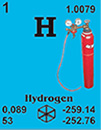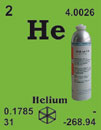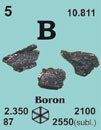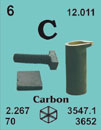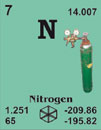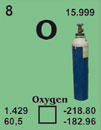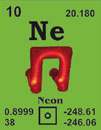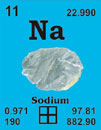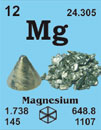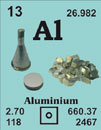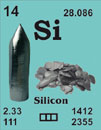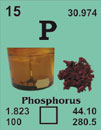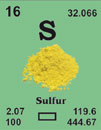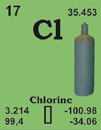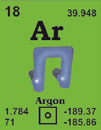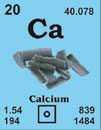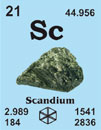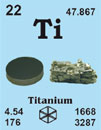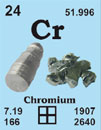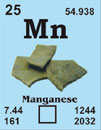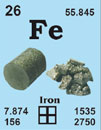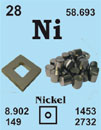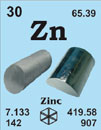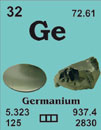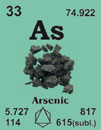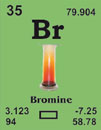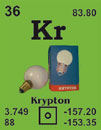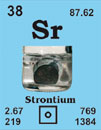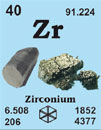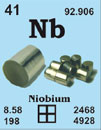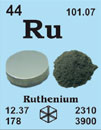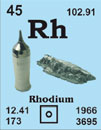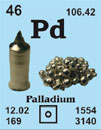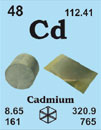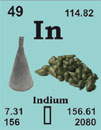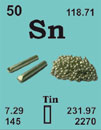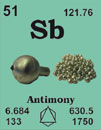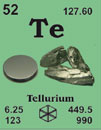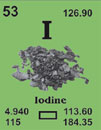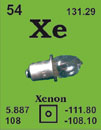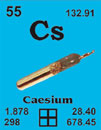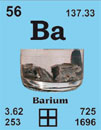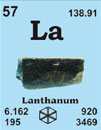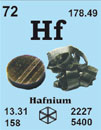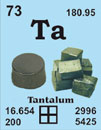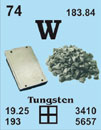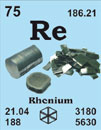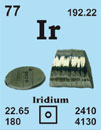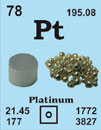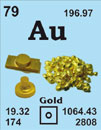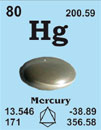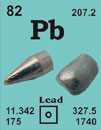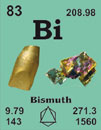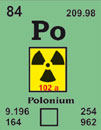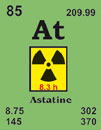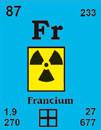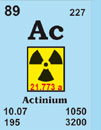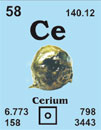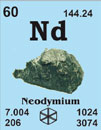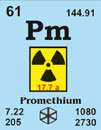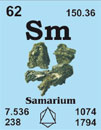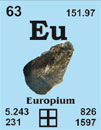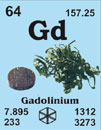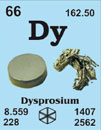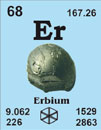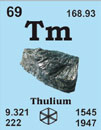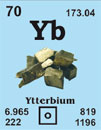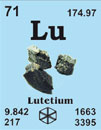Material, Technologie
& Kristalle GmbH
& Kristalle GmbH
Ihre Verbindung zu uns

-
 English
English
-
 Deutsch
Deutsch
Warenkorb
0
Artikel
Artikel
Keine Artikel
0,00 €
Gesamt
Gesamt zzgl. MwSt.
Artikel wurde in den Korb gelegt
Menge
Sie haben 0 Artikel in Ihrem Warenkorb.
Es gibt 1 Artikel in Ihrem Warenkorb.
Versandkosten (o. MwSt.)
noch festzulegen
Gesamt
(o. MwSt.)
Niob (Nb)
Wir sind führender Hersteller und Lieferant von Forschungsmaterialien
Niob 41Nb92.906
1801 von C. Hatchett in London, UK, entdeckt.
[Griechisch, Niobe = Tochter des Tantalus]
French: Niobium
English: Niobium
Italian: Niobio
Spanish: Niobio
Beschreibung: Blankes, silberfarbiges Metall, in reinem Zustand weich. Korrodiert nicht, da es durch eine Oxidhaut passiviert wird. Wird durch heiße konzentrierte Säuren angegriffen, nicht durch geschmolzene Alkalien. Verwendung in rostfreien Stählen.
Niob single crystal properties
| State: | single crystal |
|---|---|
| Crystal structure: | bcc |
| Production method: | Floating Zone |
| Standard size: | diameter 8-12mm thickness 1-2mm |
| Orientation: | (100), (110) and (111) |
| Orientation accuracy: | <2°, <1°, <0.4° or <0.1° |
| Polishing: | as cut, one or two sides polished |
| Roughness of surface: | <0.03µm |
| Purity: | 99.99% |
| Typical analysis (ppm): | C 3 H < 1 O 9 N < 5 Cu 1.60 Fe 1.80 Ni < 1 Pb 0.30 Si 0.30 Ga, Hf and Ta are below the detection limit |
Materials properties
| Density: | 8.4 g/cm3 |
|---|---|
| Melting point: | 2467.85 °C / 2741 °K |
| Boiling point: | 4741.85 °C / 5015 °K |
| Molar volume: | 10.84 cm3 |
| Thermal conductivity: | 53.7 [300 K] Wm-1K-1 |
| Coefficient of linear thermal expansion: | 7.07 x 10-6 K-1 |
| Electrical resistivity: | 12.5x 10-8 [273 K] Wm |
| Mass magnetic susceptibility: | +2.76 x 10-8(s) kg-1m3 |
| Young's modulus: | 104.9 GPa |
| Rigidity modulus: | 37.5 GPa |
| Bulk modulus: | 170.3 GPa |
| Poisson's ratio: | 0.397 GPa |
| Radii: | Nb5+ 69; Nb4+ 74; atomic 143; covalent 134 |
| Electronegativity: | 1.6 (Pauling); 1.23 (Allred); 4.0 eV (absolute) |
| Effective nuclear charge: | 3.30 (Slater); 6.70 (Clementi); 9.60 (Froese-Fischer) |
| Number of Isotopes (incl. nuclear isomers): | 31 |
| Issotope mass range: | 86 -> 103 |
| Crystal structure, (cell dimentions / pm), space group | bcc |
| X-ray diffraction: mass absorption coefficients: | CuKα 153 (µ/r) / cm2g-1 MoKα 17.1 (µ/r) / cm2g-1 |
| Neutron scattering length: | 0.7054 b/10-12 cm |
| Thermal neutron capture cross-section: | 1.15 sa / barns |
Biological data
| Biological role: | none |
|---|---|
| Toxicity | |
| Toxic intake: | n.a. |
| Lethal intake: | LD50 (chloride, oral, rat)= 1500 mg kg-1 |
| Hazards: | Niobium and its compounds may be toxic but there are no reports of humans beeing poisoned. Niobium dust causes eye and skin irritation. |
| Level in humans | |
| Blood: | 0.005 mg dm-3 |
| Bone: | <0.07 p.p.m. |
| Liver: | 0.14 p.p.m. |
| Muscle: | 0.14 p.p.m. |
| Daily dietary intake: | 0.02 - 0.6 mg |
| Total mass of element in average [70 kg] person: | < 1.5 mg |
Geological data
| Mineral | Formula | Density | Hardness | Crystal apperance |
|---|---|---|---|---|
| Betafite | (Ca, U)2(Ti, Nb, Ta)2O6(OH) | 4.5 | 4 - 5.5 | cub., waxy/vit. black/greenish |
| Columbite | (Fe, Mn)(Nb, Ta)2O6 | varies | c. 6 | orth., opaque sub.met. lustre |
| Fergusonite | YNbO4) | 5.7 | 5.5 - 6.5 | tet., vitreous, sub-met. black |
| Samarskite | (Y, Ce, U, Fe)3(Nb, Ta, Ti)5O16 | 5.69 | 5 - 6 | orth., vitreous/resinous black |
| Chief ore: | columbite, samarskite, betafite; obtained as a by-product of tin-extraction. |
|---|---|
| World production: | 15 000 tonnes/year |
| Main mining areas: | Australia, Zaire, Brazil, Russia, Norway, Canada, Madagascar |
| Reserves: | n.a. |
| Specimen: | available as foil, powder, rod, turnings or wire. Safe. |
| Abundances | |
|---|---|
| Sun: | 79 (relative to H = 1 x 1012) |
| Earth's crust: | 20 p.p.m. |
| Seawater: | |
| Residence time: | |
| Classification: | |
| Oxidation state: | V |
Übersicht der Elemente mit Zugang zu unserem Shop
Tel.: +49 (0) 2461 - 9352 - 0
Fax: +49 (0) 2461 - 9352 - 11
Fax: +49 (0) 2461 - 9352 - 11

